|
Startseite
|
|||
Oxford lecture transparencies and notes Oral presentation, not citable, because the form does not follow the official standard of articles 
– We are concerned here with incipient stuttering and persistence of the primitive sucking reflex and of the tonic labyrinth reflex, the TLR backwards. – I got to this point in three stages: research in another context, therapeutic work and observations and finally the conclusions. – Stuttering is not only important because of its therapeutic implications, it can also tell us something about the nature of speech sound production. – At the moment it occurs we can look inside to see how it works. – We will not see it with chronic stuttering. – There the core problem has shifted and has been enriched by conditioned concepts mixed with emotional and social influences. – For many years people thought that stuttering was a product of an unfavourable emotional and social environment, functional patterns were largely ignored. – Donīt misunderstand me. – Of course there are always emotional and social elements, which have to be given attention in therapy as you can see in this diagram. – There is no "one-fits-all" solution. 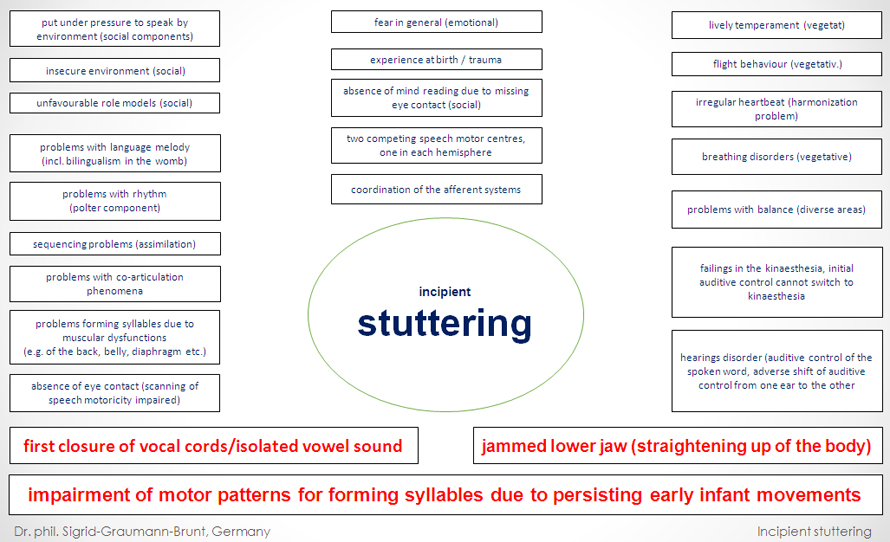
– In a study in Hamburg in the 90es we found, that the children with the highest articulation impairment did not follow the standard age related pattern of speech sound acquisition in two respects: 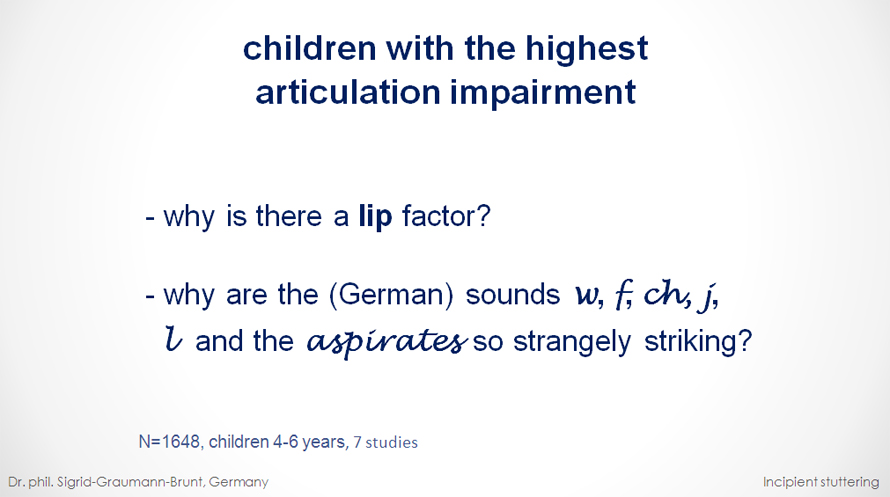
– There was a lip-factor and these consonants you can see here were strangely striking. – There was no explanation for that. This was the first stage. – It was not until after some years of practice in the therapy of stuttering that I came across these very same sounds again. – At that time the exercises which were available for the treatment of incipient stuttering were somehow proving inadequate. – So I had to make my own observations in unknown territory. 
– There were other observations, but we deal with them later. 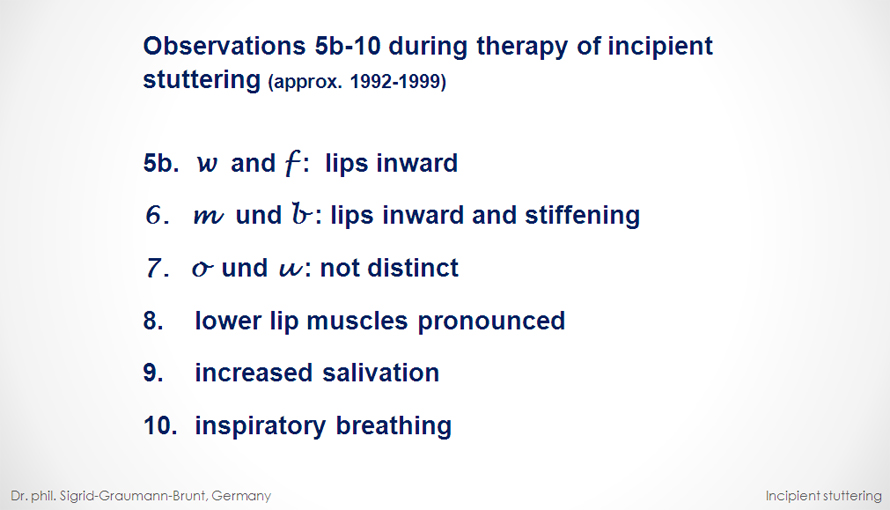
– Let us first look at points 1-5. – The f and w sounds, which were striking in the studies are dreaded by people who stutter. So I started with them. – With the help of my patients I examined the production of these sounds. 
– We found a slight tensening that began in the lower back region and travelled upwards. – The same was the case with the other sounds mentioned and above all to the production of the aspirates. – There were synergists active deep down inside the body when speaking; synergists with different patterns. – They seemed to be connected with the strength and the melody of the voice. – Second we looked at the forward movement of the lower jaw. This is a synergistic part of syllables containing the sound "i". 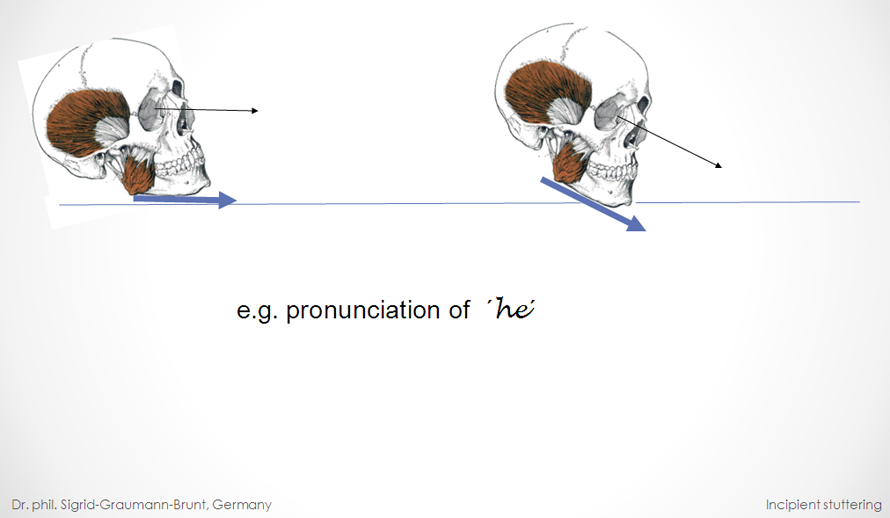
– From a certain age onwards the forward movement of the lower jaw is necessary as a social sign of self-assertion in conversation. – It needed a slight tilting back of the head. – If you canīt tilt the head back, you canīt use the lower jaw properly because the physical forces pull the tip of the chin downward; one child couldnt get its jaw back and another with a prominently protruding chin has a dystonic trembling of the masseter muscle. – The head position does play a role, as you can see, in aiding or hindering eye contact. – The third thing we found, was, that unnormal tension in the back impaired the initial glottal stop. 
– This requires a rolling movement from the pelvis up, in my opinion identical to the occlusion of the vocal cords when vomiting. I had a young patient with mutism who often vomited, when she was urged to speak. – This difficulty with the initial glottis stop can lead to the production of an isolated vowel. – It is known in phonetics that isolated vowel sounds are represented on both sides of the brain. – When a syllable-vowel is processed in the opposite hemisphere it may lead to confusion. – The kind of problems I was encountering suggested that I had to pay more attention to the pelvic region and the cervical spine. – This is why I began to focus more on problems stemming from KISS-syndrom (kinetic imbalance due to sub-occipital stress). 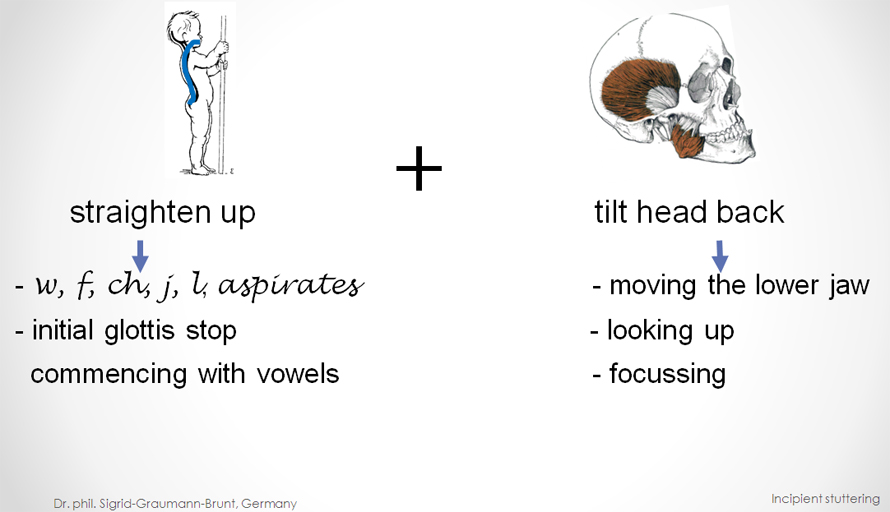
– Children that stuttered also often had blocks in the head joints. – Once treated there was an improvement in their overall development and also in their speech flow. – If work was not done on the functional patterns, the risk of a relapse was greater. – This was the second stage involving some research on KISS-syndrom. – However, it wasnīt till I turned my attention to persisting primitive reflexes that I found myself nearer to a solution. – Remember the problems we found with straightening up and tilting the head back. – The two cannot be seen independently of one another, for example when you take up an upright posture, you automatically tilt your head back. – The stiffening of the back muscles observed in stuttering showed similarities to the persisting TLR backwards. – And indeed we found this persisting TLR backwards in many of the young patients. – A slight tilting back of the head was enough to stiffening their back. – Since then I have the opinion that the TLR backwards impedes the production of speech. It affects lot of syllables, around 50% of the consonants in German. With all of them the contribution of their synergists deep down inside the body can be disturbed. – It is the TLR backwards as well which affects the patterns of the initial glottal stop and the movement of the lower jaw. – This hinders not only the process of speaking and the assumption of an upright posture but also leads to an unhealthy state and to a lesser activation of the receptors in the back. – The children looked down at the floor when talking to a grown-up, not because they were embarrassed, they simply werenīt able to look up at them. – In the observations 5b-10 mentioned above everything pointed to the presence of a persisting primitive sucking reflex. 
– 5b: The w- and f-sounds are formed with the lips turned inwards, which is uncommon in German; they avoid a triggering of primitive fixed action patterns in the lips. – 6: The same happens to the inward movement and stiffening of the lips when producing the m- and b-consonants. – 7: The rounding of the lips necessary to form the u and the o is similar to how babies round their lips when grasping the mammilla; it has to be avoided. – 8: The pronounced muscles below the lower lip I attributed to repeated attempts at moving the lips outwards. – Just as the pronounced throat muscles can be attributed to keeping the head in a forward position to avoid the TLR backwards. – 9: Salivation also plays a role in that. You can see the association with food intake. – The fact that the latter is known to have more to do with the other hemisphere and not with the fine-motor oriented hemisphere is a further problem. – 10: This also explains the inspiratory breathing observed during stuttering. – Examinations almost always confirmed a persisting sucking reflex in cases where these phenomena had been observed. – - The lip factor previously found made sense in this context and could thus be explained. Problems can mount up: Here are two examples: – The striking f- and w-sounds are particularly vulnerable - they can be affected in two ways: - by the persisting TLR backwards that disturbs the movements of the synergists as well as by the sucking reflex because of the lips being involved. – The same happens with words beginning with lip rounded vowels. They are also at risk of impairment from two sources: first here the initial glottal stop may be affected due to problems in the back and secondly on account of its proximity to the intake and digestion of food. 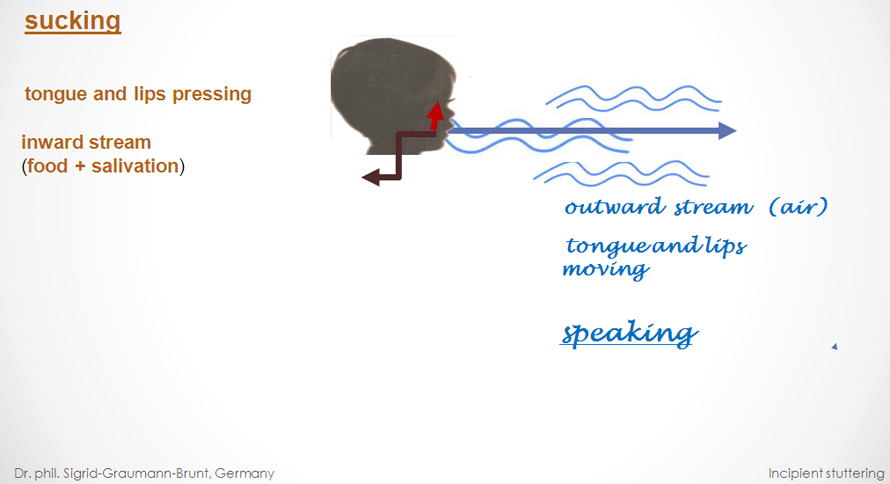
– It is quite obvious: The outward flow of breath happens at the same place as the inward sucking movement. A stalemate results. - It is the same when the persisting TLR backwards is active. It triggers movements in a direction incompatible with that required for speech. 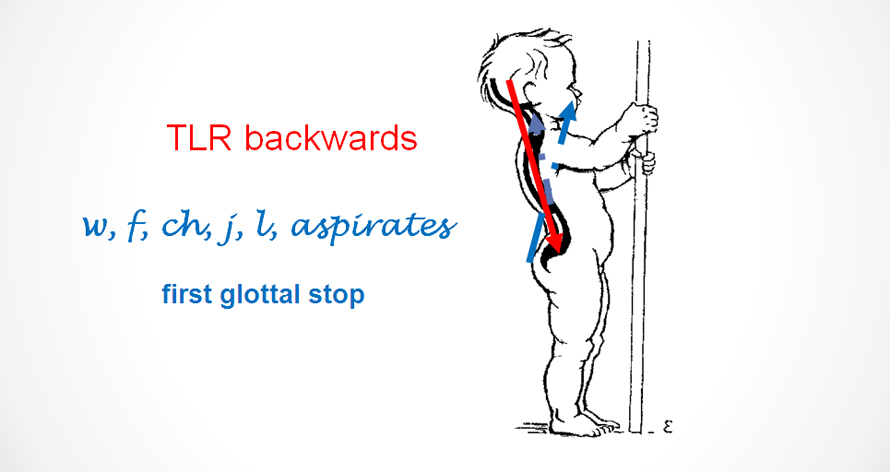
– But not only that: Persisting primitive reflex movements have their roots in a time and place where there is no consciousness and no self-control. 
– This would explain why stuttering patients often describe that they donīt remember that they had just stuttered, nor are they aware of what they did. – This was the third stage which offered a better explanation. – Stuttering may also arise for other reasons mentioned before, but from my own experience the persisting TLR backwards combined with the sucking reflex have become a classic where incipient stuttering is concerned. 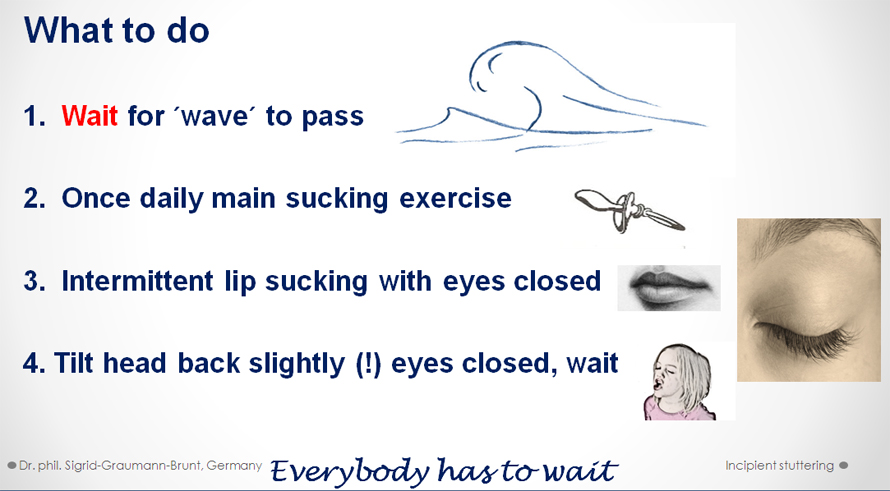
– What can we do? – A crucial piece of advice I can give when speech flow is impaired by persisting primitive reflexes is to wait. That means the patient and the people around. – These primitive reflex movements are stubborn, potent and hard to break down like a heavy wave. – If they hook onto other motor concepts and are frequently repeated, there is a danger: this person could experience devastating conditioned concepts. – Close your eyes when doing exercises und in between. – That is a good thing to do when persisting primitive reflexes are involved. – This may be due to the effect of light diffusing the closed eyelid which acts upon the non-image-forming visual pathways. This may create a momentary womb-like environment, which may be why it works in practice so very well. – One "main" therapeutic teat sucking session once a day is to be done. If you not sure, how the Padovan teat-trainer works, ask me afterwards. – Short easy exercises can be done in between-times like sucking the lips inwards with eyes closed or drinking through a straw with eyes closed etc.. – Tilt the head back slightly beyond the perpendicular with eyes closed. – Make sure beforehand, there is no KISS-syndrom. – Kids have reported that they even do this voluntarily at school. – Everybodys waiting and relaxing has a good influence. – The more the parents understand where the problems lie, the easier it is for them to deal competently with the situation. – Best of all get the parents to do the exercises as well because quite often they have similar problems themselves. – I have presented you some of my theoretical assumptions, but the crucial criterion is that I am not seeing my stuttering patients for as long as I used to. 
|

